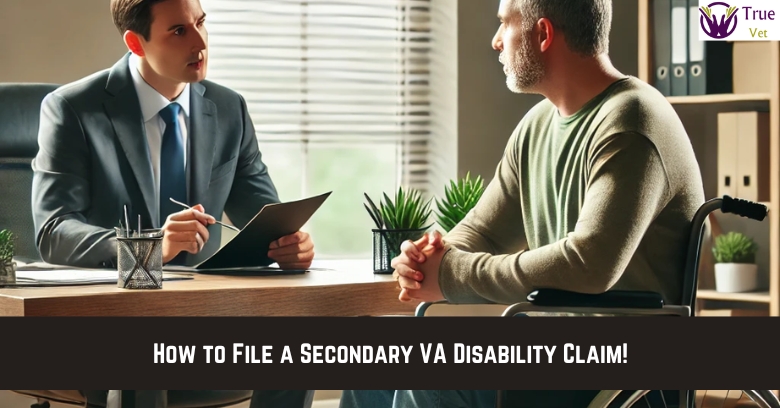Steps to Submitting a Secondary Claim for VA Disability
Middleburg, United States - March 4, 2025 / True Vet Solutions /
Veterans who suffer from service-connected disabilities may develop additional health conditions related to their primary disability. These secondary conditions can significantly impact daily life, making it essential to secure the benefits rightfully earned through service. Understanding how to file a secondary VA disability claim is crucial for ensuring financial stability and receiving the appropriate medical care. A newly published blog on True Vet Solutions provides an in-depth guide to navigating this process successfully.
Eligibility Criteria for Secondary VA Disability Claims
The VA system recognizes that certain medical conditions arise as a direct result of a service-connected disability. Veterans may qualify for secondary VA benefits if their condition is linked to an already approved disability. Eligibility depends on three key factors:
The veteran must have an existing service-connected disability recognized by the VA system.
A secondary condition must be medically linked to the primary service-connected disability.
Medical evidence, including doctor’s statements and medical records, must establish a clear connection between the primary and secondary conditions.
Common secondary conditions include chronic pain, mental health disorders, nerve damage, and cardiovascular issues resulting from a primary service-connected disability. Establishing this connection is critical to securing additional VA benefits.
Filing a Secondary VA Disability Claim: Step-by-Step Process
Filing a VA disability claim for a secondary condition follows a structured process. Veterans must provide strong medical evidence and complete the necessary documentation to improve their chances of approval. The process includes:
Gather Medical Documentation – Obtain medical records detailing the secondary condition, its symptoms, and how it is related to the primary disability. Physician statements and diagnostic test results serve as critical evidence.
Obtain a Nexus Letter – A medical professional should provide a nexus letter that explicitly connects the secondary condition to the service-connected disability.
Complete VA Form 21-526EZ – This is the official application form for disability compensation claims, including secondary conditions.
Submit the Claim Through the VA System – Veterans can submit their claims online through the VA system portal, by mail, or in person at a regional VA office.
Attend a Compensation & Pension (C&P) Exam – The VA may schedule an evaluation to assess the severity of the secondary condition and confirm its connection to the primary disability.
Each step is essential to ensuring the VA properly processes the claim, reducing the likelihood of delays or denials.

Processing and Review of a Secondary VA Disability Claim
Once a VA disability claim for a secondary condition is submitted, the VA system follows a structured review process:
Claim Review – The VA reviews the submitted evidence, medical records, and nexus letter to assess eligibility.
C&P Exam Evaluation – If required, the results of the Compensation & Pension exam play a significant role in the final decision.
Decision Notification – Veterans receive a formal decision letter explaining the outcome of their claim and the percentage of disability granted.
Appeal Process (If Needed) – If a claim is denied or assigned a lower-than-expected disability rating, veterans can file an appeal through the VA system to seek reconsideration.
The processing time varies, but veterans can track their claim status online through the VA system portal.
The Importance of Secondary VA Disability Claims
"Many veterans are unaware that conditions linked to their service-connected disability can also qualify for benefits," said Tracy Glover, owner of True Vet Solutions. "For example, if a veteran suffers from PTSD and later develops high blood pressure due to the stress, that secondary condition can be covered under the VA system. Ensuring veterans understand their rights and how to document these connections properly is crucial. Keeping detailed medical records and obtaining a strong nexus letter can significantly improve the chances of claim approval."
Filing a claim for secondary VA disability ensures veterans receive comprehensive healthcare coverage and financial support for conditions that develop due to their military service. The VA system acknowledges that service-related disabilities can worsen over time, leading to new medical challenges. By successfully filing for secondary VA benefits, veterans gain access to:
Increased monthly compensation to cover medical costs and lost income.
Expanded access to specialized healthcare services.
A higher overall disability rating, which may unlock additional VA benefits.
True Vet Solutions is committed to helping veterans understand and navigate the claims process, ensuring they receive the full support they deserve. To navigate secondary VA disability claims, visit True Vet Solutions’ blog post at “How to File a Secondary VA Disability Claim!”
About True Vet Solutions
True Vet Solutions is dedicated to assisting veterans in understanding and securing their VA benefits. By offering expert guidance and resources, True Vet Solutions helps veterans navigate the complex VA system to maximize their disability compensation.
If needing help with a VA disability claim, True Vet Solutions can help get the benefits necessary to increase a service member's quality of life – call (904) 774-2189 for help to get the disability rating and benefits that are deserved!

Contact Information:
True Vet Solutions
3907 Pipit Point
Middleburg, FL 32068
United States
Tracy Glover
(904) 523-9035
https://www.truevetsolutions.com/
Original Source: https://truevetsolutions.com/how-to-file-a-secondary-va-disability-claim/


